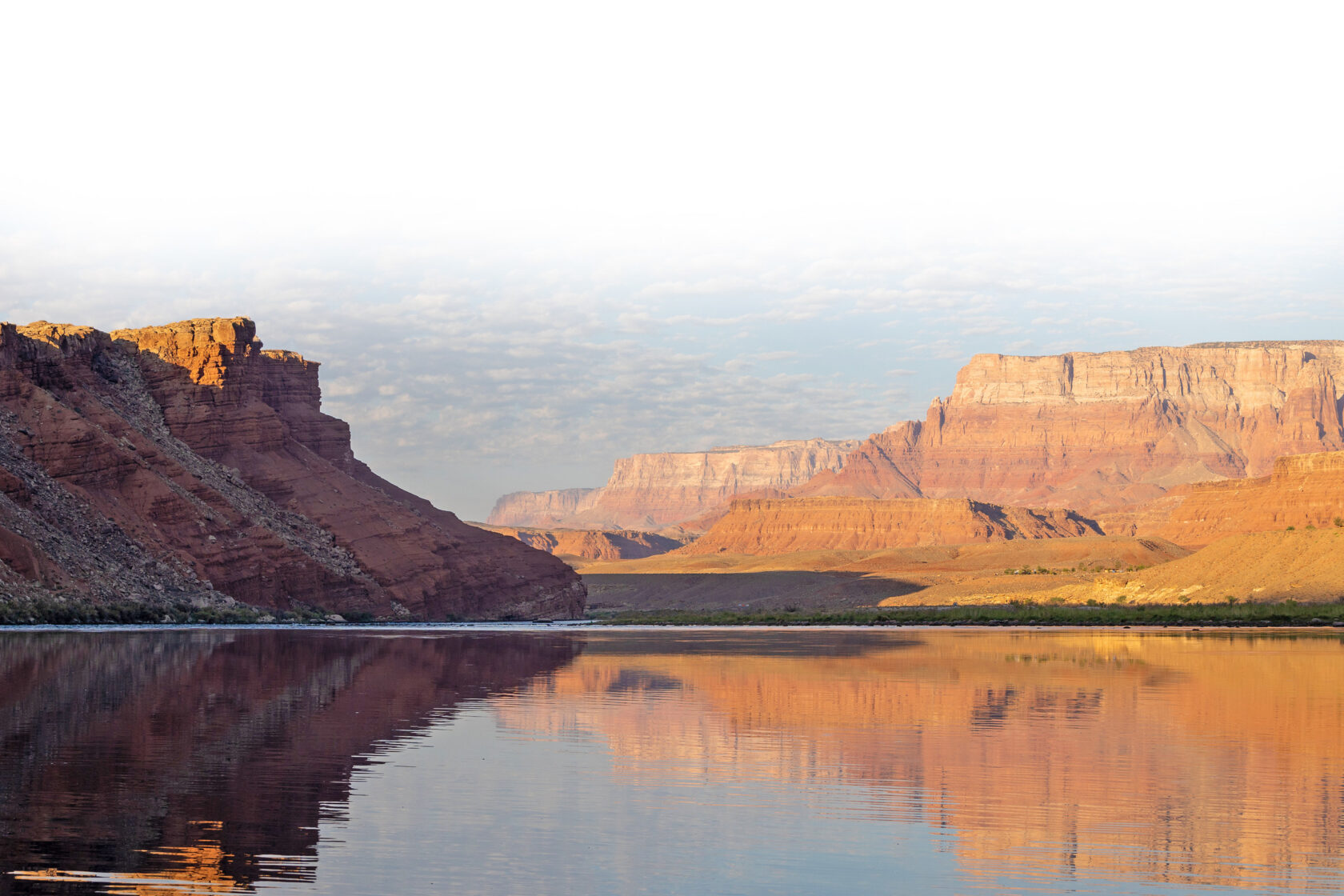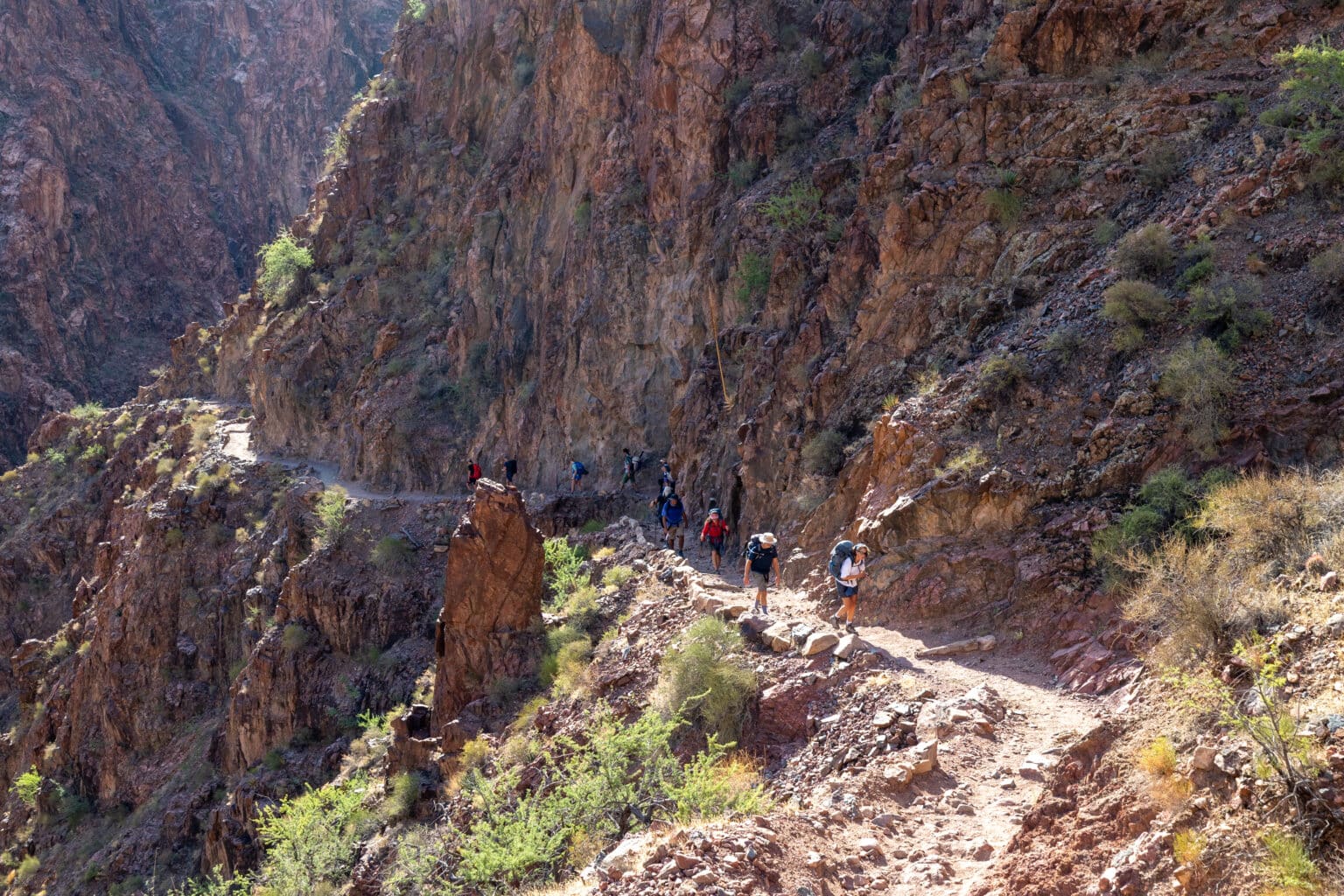
Hiking the bright angel trail
For river trips beginning or ending at Pipe Creek, participants must hike in or out of Grand Canyon between the South Rim and the Colorado River.
The hike along the Bright Angel Trail is serious, long (7.7 miles) and strenuous. It takes you in or out of one of the deepest canyons in the world with an elevation increase/decrease of more than 4500 feet and may be one of the most physically demanding endeavors you will undertake in your life.
The hike requires carrying a weighted backpack (20-30 pounds) of your personal effects, along with some food and 2-3 liters of water (additional 8-10 lbs.).
It is essential you can comfortably complete the hike carrying a weighted backpack.
The combination of carrying a backpack, the potential for extreme heat—up to 120 degrees in the summer— and the elevation change can make this hike exhausting for even the most physically fit and prepared hiker.
When evaluating the prospect of participating in a river trip requiring this hike, please be honest with yourself. If you are not already a backpacker or frequent hiker, this trip may not be right for you. You must be committed to doing additional training and conditioning before you begin your trip. You must be able to carry your own backpack. Potential inability to successfully complete the hike endangers not only you, but also the other guests and guides on the trip.
Please read our Essential Eligibility Criteria for Grand Canyon Trips with Hike In or Out. If you’re unsure if you meet the physical requirements to safely complete this hike, call your Adventure Consultant.
This hike is not recommended for anyone in poor general health, the elderly, those with heart conditions, lung disease, joint issues, back problems, a sedentary lifestyle or those who are not physically fit.
As required by the National Park Service, we have a hike escort accompanying our guests on the hike. Essentially you hike at your own pace, with the hike escort being the “sweep” person following the last hiker in the group. You should be able to maintain a pace of at least one mile per hour. Our hike escorts are well trained and have a great deal of experience hiking the Bright Angel Trail. They can give you great advice and hiking tips, but are not responsible for carrying you or your gear into or out of the canyon.
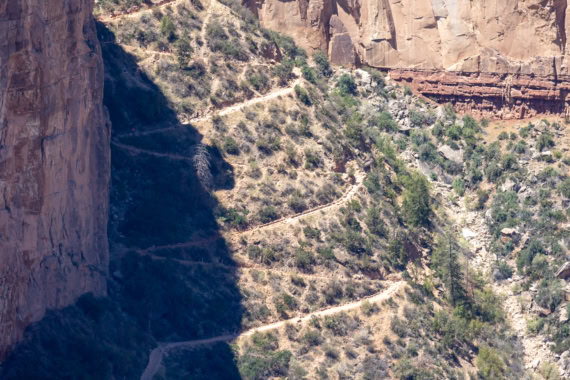
The Trail
The Bright Angel Trail is a well-defined, maintained, packed desert sand/dirt trail and offers some spectacular views of Grand Canyon. It is characterized by reinforced trail logs that run perpendicular to the path, creating uneven “stairs” that put even more strain and impact on your body. Drinking water is available (subject to pipeline breaks) throughout the year at Havasupai Gardens. Water is also available seasonally (May-September) at 3 mile and 1.5 mile resthouses along the trail. Composting toilets are located at 1.5 Mile Resthouse, 3 Mile Resthouse, Havasupai Gardens and Pipe Creek-River Resthouse.
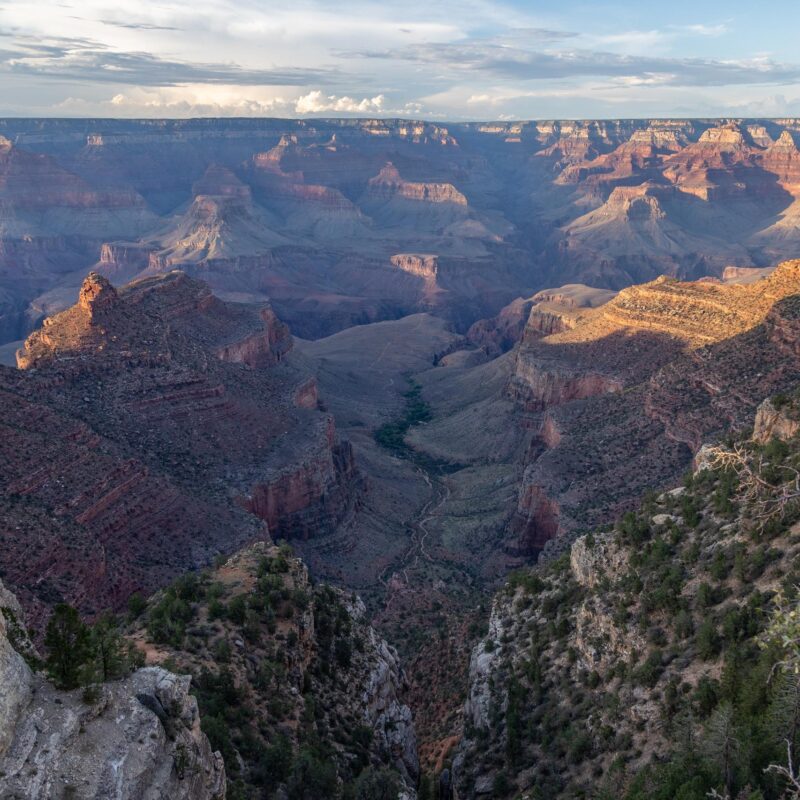
Hiking In
Trips Beginning at Pipe Creek
Most people assume hiking downhill is “easier” than hiking uphill because gravity naturally propels your body downward, making it seem far less strenuous than hiking uphill. However this is not the reality. There are considerable punishing impacts on your joints (knees, hips & ankles), leg muscles and feet. Downhill hikes fatigue muscles quickly because the legs must hold back your full bodyweight and backpack with every step. The additional pressure from stepping down and across the uneven retaining log “stairs” can create great strain on your knees and joints. Most hikers find it is much more physically challenging to hike downhill than up.
You must have stamina, muscle and core strength, as well as balance, which may be more challenging for people with older joints. The hike down to the river generally takes between 4-7 hours. There is a limited amount of time to complete the hike because the trip must continue downstream and immediately run a Class 6 rapid.
If during the hike you are not able to keep a certain pace and/or your hike escort feels you cannot safely complete the hike in the designated time or arrive at your river trip in good physical health, you may be asked to return to the rim and forfeit your river trip.
When you arrive at the river, you must be in good physical condition and ready to immediately encounter some of the biggest whitewater in the canyon. If you were to end up becoming a non-voluntary swimmer, you would need to have the energy and ability to actively participate in your own self-rescue and possibly swim through rapids. Being exhausted from the hike has the potential to present a dangerous and potentially life-threatening situation for yourself and other participants on the trip.
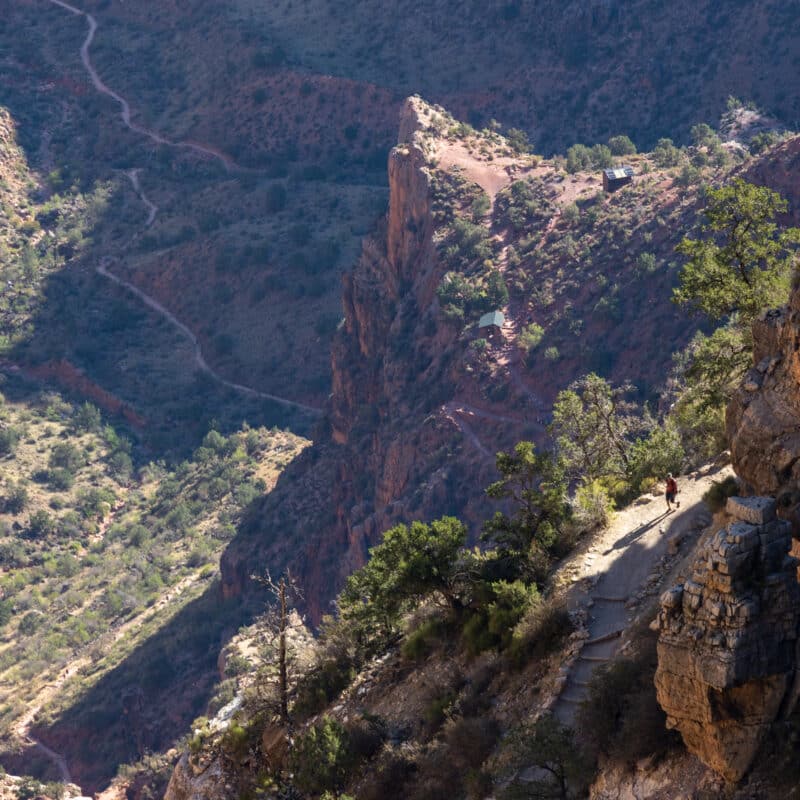
Hiking Out: Lees Ferry to Pipe Creek Trips
Trips Ending at Pipe Creek
Hiking out of Grand Canyon is a cardiovascular workout and also requires a great deal of muscle strength. It is essentially uphill the entire route, climbing about one vertical mile in elevation. You need to be prepared for a long, arduous hike. As you ascend the trail and gain elevation, the hike increases in difficulty putting more strain on the lower part of your body, back, and cardiovascular system. One of the most difficult parts of the hike is closest to the rim after you have already hiked a long distance uphill. You will encounter more uneven “stairs” and what seems like never-ending switchbacks, taxing your already fatigued body. The hike with a backpack is a tremendous challenge and generally takes between 6-9 hours.
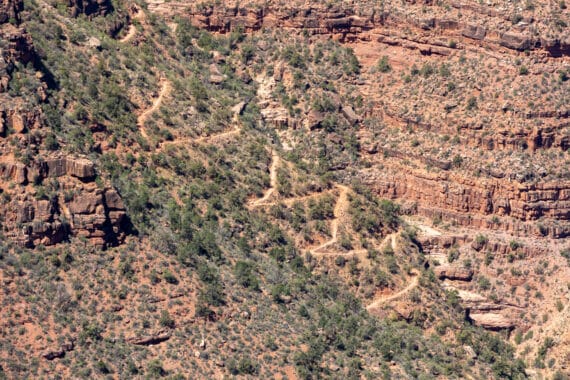
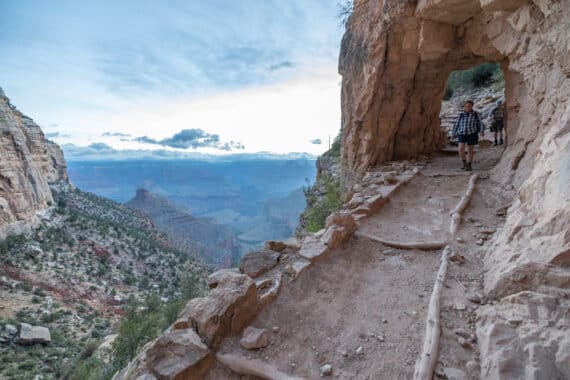
Preparing for your hike
The best way to get ready for a hike in Grand Canyon is to combine cardiovascular (aerobic) exercise, strength training and hiking. Walking or slow jogging is not enough. More strenuous activity such as lengthy hikes on inclines, cycling, running or swimming is required. Your best exercise is to do the real thing—hiking. Start with shorter hikes and then increase your distance and pace. Try to do your hiking on dirt trails with up and down paths. You want your ankles, knees and muscles to get used to uneven loose terrain. Working out at the gym will increase your cardiovascular fitness, but will not prepare your muscles for the irregular surfaces that you will find in the Grand Canyon.
While training, it is helpful to carry your loaded backpack to strengthen your upper back and shoulders. Also, wear the same footwear and clothing that you will be using for your Grand Canyon hike.
Before starting any exercise regimen you should consult your doctor and have a physical check-up. Enlisting the services of a personal trainer or participating in a supervised gym workout program is a great way for you to stay on track and be ready for your hike, but is not necessary. Here are some examples of exercises you should incorporate into your training to prepare your muscles:
Three months before your trip, you’ll receive a hiking form to fill out. Please be honest; let us know where you are in your training at this three month mark.
Gear
Backpack
You will need to provide your own backpack. We strongly recommend an internal frame or frameless pack with a padded hip belt and shoulder straps that fits you well. External frames are discouraged. It should not exceed 40-45 liter (2500-2700 cubic inches) capacity. We provide all the sleeping equipment – sleep kit (sleeping bag, sleeping pad, sheet and pillow) as well as a tent and tarp. Your backpack will contain all your personal gear, plus snacks for the hike and 2-3 liters of water.
Footwear
For the Bright Angel Trail hike you will want lightweight hiking boots or shoes. Good ankle and arch support are important as well as durability and room for your toes. If you are purchasing new footwear, allow plenty of time to break it in prior to the hike. This footwear will also be used for side canyon hikes. You will therefore want good tread for traction on the trail and well as for hiking across rocks and loose terrain.
Trekking Poles
Highly recommended. When used properly, trekking poles can help distribute the weight of your pack, take some pressure off of your legs and provide stability, especially when hiking on steep trails. The poles need to be collapsible, but do not need to fit into your waterproof bag. Your guides will store them on the boat separately.
Hiking Socks
Consider investing in some good hiking socks with heel/toe cushioning. Keep an extra pair of socks near the top of your pack in case you wish to change into a fresh pair during your hike.
Hiking tips
Hydrate
Start drinking extra water in the days leading up to your hike and continue this regimen throughout your trip. It is important to be diligent about hydration in this dry desert environment. Be mindful to limit your alcohol consumption which contributes to dehydration.
Dinner
Eat a good dinner the night before the hike.
Breakfast
Consuming a nourishing breakfast will provide you with a good base fuel to get you started on the trail. As you hike you will continue to snack and drink water.
Pace Yourself
Maintain a reasonable, even pace that everyone in your party is comfortable with. If you can carry on a conversation, you are hiking at the right pace. If you find that you are out of breath, then you are not getting enough oxygen. Lack of oxygen may cause fatigue, heavy legs, and exhaustion.
Rest Often
Whenever possible, find a shady spot, sit, and rest. Prop your legs above your heart to drain the lactic acid that has built up in your legs. A short 5- to 10-minute break every hour will make your hike easier and more enjoyable even if you don’t feel fatigued. Eat and drink while resting.
Water
Drink water, but don’t force it. When hiking in a group, each individual person should carry 2–3 liters of water, depending on how hot it is. One person carrying the water for the group should not be attempted. Be sure your water is full when leaving Havasupai Gardens. Even though the Bright Angel Trail has water along the way, you need to carry water. A common mistake is not carrying enough water. Be aware of the following signs of dehydration: dizziness, nausea, irritability, cool clammy skin, and dark colored urine (darker than normal).
Eat Well
Your body will be burning a lot of energy. You may only feel thirsty and not hungry, but it is important that you also eat frequent snacks (trail mix, salty snacks, protein, etc.) to balance your liquid consumption with food intake. This will help prevent heat illness. Your body needs the fuel to successfully complete the hike, so this is not the time to skimp on food.
Take Care of Your Feet
Trim your toenails to a reasonable length a day or two before starting your hike. This is especially important for guests hiking into the canyon. Be sure to bring blister treatment such as blister bandages, moleskin and small bandages. Watch for “hot spots” and administer protection before a blister forms. Change socks, slow down, rest in the shade.
Dousing
In hot weather, whenever you are near a water source, pour water on your head and cotton shirt until you are soaked. This will help you keep your body temperature cool while you are hiking and your energy level up.
Discover your next OARS Adventure
